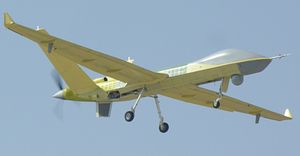China’s indigenously designed and built next-generation medium-altitude long-endurance and strike-capable Wing Loong II unnamed aerial vehicle (UAV) has purportedly set a new “record” by hitting five successive targets with five separate types of missiles during a recent flight test, the UAV’s manufacturer, state-owned Aviation Industry Corporation of China (AVIC), said in a recent statement, according to Chinese media reports.
“The Wing Loong II UAS [unmanned aerial system] has successfully hit five targets in succession with five different types of missiles in a single sortie, setting a new live firing record for Chinese UAS,” AVIC said. The new UAV has performed a number of flight and firing tests with eight types of missiles and various bombs, purportedly performing a hit rate of “100 percent,” Xinhua news agency reported, citing AVIC.
The Wing Loong II UAV successfully completed its first maiden flight on February 27, 2017. As I reported in March 2017:
China’s latest strike-capable drone has been designed and developed by the Chengdu Aircraft Design and Research Institute, a subsidiary of AVIC. With an overall length of 11 meters, a wingspan of 20.5 meters, and a height of 4.1 meters, the Wing Loong II UAV was first publicly revealed at the Airshow China 2016 in November 2016. At the airshow, China Aerospace Science and Technology Corporation’s (CASC) for the first time publicly displayed a prototype of its latest and most capable attack and reconnaissance UAV, the Caihong 5 (CH-5), or Rainbow 5.
The Wing Loong II is an upgraded variant of the Wing Loong UAV first introduced into service with the People’s Liberation Army Air Force in 2008. An export version of the drone has been sold to a number of international customers including Egypt, Saudi Arabia, the United Arab Emirates, Nigeria, Uzbekistan and Kazakhstan. As I reported last year, Pakistan has also expressed interested in the weapon system. In terms of size and payload, the original Wing Loong combat drone is comparable to the General Atomics MQ-1 Predator, which is slated to be retired by the U.S. Air Force by the end of the year.
The Wing Loong II UAV can carry a number of different missiles and bombs including Lan Jian 7 (Blue Arrow 7) laser-guided air-to-surface missiles, TG100 laser/INS/GPS-guided bombs, and the AR-1/HJ-10 anti-tank missile — the Chinese equivalent to the American-made Hellfire missile. Overall, the Wing Loong II can purportedly carry a payload of up to 400 kilograms. The UAV can fly for about 20 hours with a maximum speed of 370 kilometers per hour. The Wing Loong II has an operational radius of 1,500 kilometers.
The UAV has been primarily developed for export and has been marketed by Chinese developers as a cheaper alternative to the MQ-1 Predator. The per-unit price is estimated at around $1-2 million in comparison to, for example, the MQ-9 Reaper’s $30 million. In March 2017, China announced that it Saudi Arabia is interested in procuring up to 300 Wing Loong II UAVs.
“[I]t has been reported that the Wing Loong UAV series (along with other Chinese combat drones) have much weaker engines than either the U.S.-made Predator or Reaper resulting in more limited range and speed in comparison to U.S. models,” I explained elsewhere. “Chinese drones also lack in detection capabilities and overall endurance when compared to Western models.” China also lacks a global navigation satellite system.































